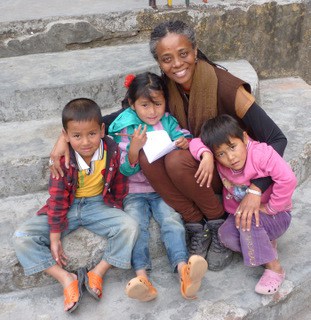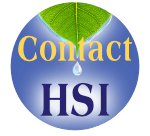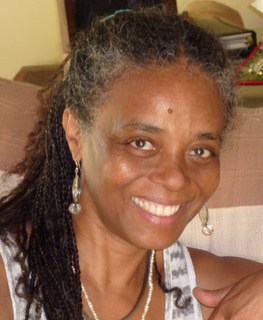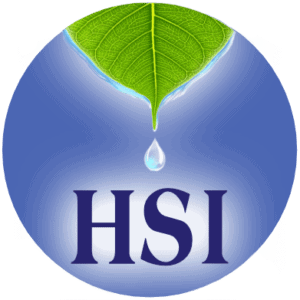HSI Newsletter February 2012
Submitted by Soma Devi Glick, CHom, D.O.M., L.Ac
It’s 10 AM on Monday morning and I just pulled up into the small yard of “Bumi Sehat”, the birthing clinic where I’ve been treating the local children of Ubud, Bali since October 2005. Ubud is about one hour’s drive from my house and the road takes me through a jungle with swift rivers cutting through deep gorges, terraced and manicured rice fields as far as the eye can see. I see temple gates with striking stone carvings, villages and bustling markets. However I never dare to take my eyes off the road for too long in order to enjoy the side views. Driving in Bali is like going through a course of obstacles, constantly dodging motorbikes, pedestrians and huge trucks, which usually suddenly appear around a bend at full speed.

With my doctor’s bag, I enter the large room where I work, set up with treatment tables. Usually several children and their parents are already waiting for my arrival. A lovely Balinese woman who serves as my translator and takes care of the administrative papers greets me and helps me set up a clean field for my equipment: a Sho-ni-shin kit (Sho-ni-shin is a painless Japanese acupuncture method well suited for infants and children), a tiger warmer (special moxa for children), and half-inch seirin needles (very thin and sharp needles). I keep an othoscope , a thermometer and a 100-remedy homeopathy kit handy.
The clinic belongs to a “Yayasan” or non-profit foundation, dedicated to the education and natural birthing of women. Robin Lim, a midwife who’s lived in Bali for over twenty years is the heart, soul and driving force for the clinic’s daily functioning. She receives many grants and donations to keep everything afloat and thousands of children were born here. Mothers come for prenatal and postnatal care and get education on vaccination, hygiene and diet. Robin has just been nominated CNN hero of the year 2011 and won the Great Prize of Honor. The clinic is well stocked with Chinese herbal and homeopathic remedies along with essential antibiotics and other allopathic drugs.
Most babies and children need treatment for fevers, colds, flu, diarrhea, stomachaches or skin rashes. With these children colds tend to turn into bronchitis very easily and linger for months. Robin has shared with me that there has been a faster recovery rate, and there have been much fewer antibiotics dispensed as a result of weekly natural treatments. Between 10 AM and 3 PM I see from 15 to 25 children.
When a kid comes in with a fever, homeopathic remedies such as Aconite, Belladona, Pulsatilla, Bryonia or Gelsemium are the first line of defense. In cases of dengue and typhoid fevers during the mosquito months, children respond well to Gelsemium, Bryonia or Rhus tox. In addition to homeopathic treatment I may also work with acupuncture by inserting very thin needles in and out, or by bleeding a jing-well point. For more chronic or deficient cases, I give a Sho-ni-shin treatment and follow up for several weeks.
Homeopathic remedies which support infants right at birth:
- Arnica helps to ease the trauma of a difficult birth.
- Antimonium Tartaricum helps cyanotic infants with trouble breathing.
- Lycopodium, especially with a colicky baby, will help if the yellow tinge of a baby doesn’t disappear in a timely fashion after exposure to morning sunlight.
- Silica and Calc. Phos have helped many children with emaciation and weak constitutions.
We see many children with birth defects or with paralysis resulting from a cerebral accident. Since allopathic medicine has nothing to offer these children alternative treatment is often the only choice. The improvement these children see with Homeopathy, the Sho-ni-shin Method, Chinese Herbal Medicine, and generally the care of many other volunteer practitioners of alternative therapy such as Sacro-cranial or Reiki, is remarkable.
Case Example:
A two year old girl was brought in with symptoms resembling hemiplegia. Her right arm and leg seemed non-functional without muscular atrophy or skeletal defect. The parents had only noticed the problem when the child should have started to walk but refused to do so. When she came for the first time, her hand was held in a tight fist and her foot just flopped to the side.
We discovered that at three months old she had been taken to the hospital with a very high fever and been on life support for three days. The parents didn’t know the diagnosis or which drugs had been given to the baby but suspected that her problem might have started from that time. On the first visit, I gave the homeopathic remedy Aconite because the little girl just screamed out of sheer terror when we tried to come near her. The following week, I was able to start Sho-ni-shin treatment and I gave her a Chinese herbal formula for the paralysis.
Amazingly, a week later the girl was able to take a few tentative steps with her mother’s help. As long as her mother held her hand, she let me work with her. The girl received homeopathic remedies, physiotherapy, and many massages which her mother continued as instructed. After a few months of treatment the girl is now able to walk by herself.
Effective homeopathic treatment often depends on the inquiry into mental emotional states of a person. In this culture it is difficult to talk about these topics. I can tell that the work I’m doing is gaining the trust of more parents. I’ve started to see an increasing number of children with emotional or stress related problems lately. Somehow, in spite of the language barrier, a beautiful rapport gets established with the kids. The children look forward to their Sho-ni-shin treatment and when it’s necessary, they accept to be needled without too much fuss. The parents can see the health benefits and are more willing to make dietary or hygienic lifestyle changes when needed.
As for me, I always look forward to my time in Ubud. The experience in this clinic is deeply enriching to my practice because of the opportunity to see so many cases and get a scope of the efficacy of using Homeopathy and Sho-ni-shin to advance children’s health and wellbeing.
Note: Sho-ni-shin is a painless Japanese acupuncture method well suited for infants and children, using small metal tools to activate the Qi by tapping on meridians and acupuncture points.


